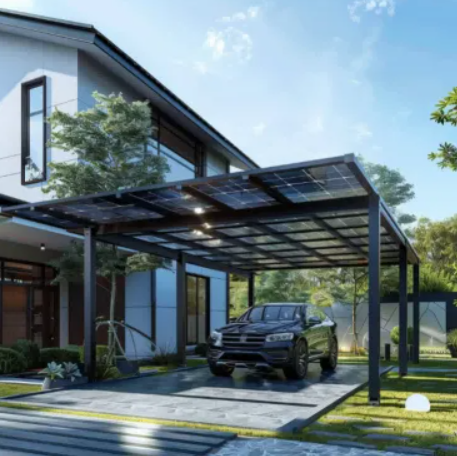Site Assessment for Solar Carport Installation
Evaluating Sun Exposure and Orientation
When designing a solar carport install location, it is essential to consider sun exposure and angle for optimal energy generation. The angle and position should be determined, from which the solar panels receive the most amount of sunlight. Instruments such as solar pathfinders or dedicated software can be used to determine seasonal sun positions and provide accurate veneer data on how light affects the site over the calendar year. Shading analysis is also important, to ensure that there are no obstructions (e.g., trees, buildings) that could block the sun and decrease efficiency.
Assessing Soil Conditions and Structural Integrity
PDD before operation Before the construction of solar carport installations, it is necessary to evaluate the soil and the structural integrity of the installation in order to ensure the structural stability of the solar car ports in the long-term. Soil testing The weight of the carport structure and panels, and its drainage ability, must be considered and tested to see if your site can take the load. It is also advisable, before any solar installations takes place, that the condition of existing structures and foundations be assessed, to ensure these are stable and fit for a solar installation. Knowledge of the local geology also helps to plan appropriate installation procedures to reduce the risk that is introduced by soil or structural factors.
Local Zoning and Permit Requirements
Local zoning and permit regulations must be negotiated in order to ensure it’s in compliance and to steer clear of any legal challenges when installing a solar carport. When you're looking out your front window, it's a lot less cool to see gravel-covered ground than to see your own slumbering yard. A quick trip to your local township office or library should give you all the information you need to know about zoning laws in your neighborhood. And being well-informed on zoning laws just means no one can stop you from having one of these on your lawn. There may be environmental studies or construction permits to secure, to make sure the project accords with legal and safety requirements. It is recommended that all parties involved consult with local governments, or experienced land use professionals, to avoid potential zoning conflicts and facilitate full project execution.
Structural Design Considerations
Material Durability and Corrosion Resistance
Tough and durable materials are essential to use in solar carport structures due to difficult environment. I suggest going with something like a galvanized steel or an aluminum, both of which are incredibly durable and corrosion resistant. These carports are constructed with materials that can withstand UV exposure, moisture, and temperature changes so that the carports stay attractive and usable with little maintenance. Other documentation from manufacturers on material performance can also provide comfort, particularly if they’ve been tested in similar installations. Because this is a very time consuming process these steps are crucial to prevent disappointments en ensuring the highest possible returns!
Load Capacity for Snow, Wind, and Debris
Consideration of load capacity in the design of solar carports is required to meet safety and structural integrity standards. By using local climate data to predict snow loads, and building your structure according to code, you can be successful in developing structures which can handle these loads. Additionally, carports should be built to endure strong winds, which can be common near beaches or in open plains. By including solutions for debris build-up the carports would offer a resilient and functional solution to an adaptable environment, as well as a solution to a threat.
Integration with EV Charging and Lighting Systems
Solar carports with EV charging stations and high efficiency lighting are a forward thinking way to increase functionality and security. If I could recommend, put EV charging condition into your design, users should be able to charge their car comfortably under the carport. With smart home integration and energy saving lighting the carport is both well lit and secure. In addition to providing the electricity supply and infrastructure required, it not only satisfies the current, but also has scalability to use for future System expansion, so that It becomes a integrated sustainable transport, energy Based solution.
Installation Best Practices
Ensuring Compliance with Electrical Codes
National and local electrical codes must be strictly followed in order to maintain the safety and effectiveness of solar carports. Knowing these standards is a necessary beginning in order to be compliant, since codes frequently mandate specific wiring and systems. It's very important that I work with licensed electricians that are knowledgeable about solar systems so that I don't end up with poor installations. Keep detailed records of all electrical work performed and maintain records of future inspections and any additional required maintenance work to keep your facility in continuous safety compliance.
Minimizing Parking Space Disruption During Construction
Without a solid construction plan, parking lots can become even more tangled than what disruption steel canopy installations usually wreak havoc. I find that when you have the bulk of the construction work done during off hours it minimizes the disruption for the Parking lot users. Furthermore, you need to keep all interested parties well-informed of any temporary alterations to parking arrangements or restrictions on access. This pre-emptive communication allows us to set expectations and facilitates a quick, simple installation with little to no business disruption.
Timeline Management for Seasonal Challenges
The schedule for solar carport is carefully managed to align with seasonal weather. A comprehensive schedule ought to be developed, including a tolerance for weather-related interruptions, such as snow or rain that could affect the construction work. Well defined milestones make progress measurable, but being flexible means that unexpected delays can be accounted for. I can coordinate with weather reports to schedule the install for maximum safety and productivity, completing the job on time – even in extreme conditions.
Maintenance Protocols for Longevity
Routine Cleaning and Debris Removal
Maintenance of solar carports is important to maintain performance and life. Setting up a normal cleaning regimen is also very important toward this regular maintenance. This includes clearing leaves, snow, grime and other debris that can settled on the panels and block their effectiveness. In order to successfully clear off solar panels without causing damage, you need to use the right tools, including soft brushes or squeegees to allow for safe removal of debris. This guarantees the panels remain free of dirt and function at 100%, providing maximum energy output.
Inspecting Electrical Components and Connections
Regular checks of the electrical parts are crucial to avoiding malfunctions. By periodically checking the electrical wiring and connections, any degradation or looseness can be detected before it becomes a larger problem. The logging for these inspections, as well as any subsequent 20 repairs, helps keep parties accountable and maintains a log for reference in the future. Addressing these problems quickly helps protect the performance and safety of the solar carport system and makes certain that it keeps working properly for years to come.
Addressing Snow/Ice Accumulation Safely
In particular for high snowfall areas, snow and ice control on solar carports is important. How to safely remove them Developing procedures for the safe removal of these is essential to avoid structural damage. This training includes training workers how to use the snow and ice removal equipment properly, prioritizing safety, to keep both the equipment and workers safe. By checking the weather forecast at regular intervals, the operator can take proactive measures to maintain the solar carport during the winter.
Cost and ROI Analysis
Initial Investment vs. Energy Savings
Calculating your initial investment versus the amount of energy that will be saved is key when deciding to install a solar carport. The front investment may be substantial, but when looking at this investment compared to energy savings incurred over time, we get a better idea of the bottom line. Businesses can make the financial planning process much easier using instruments such as payback period calculators. In addition, examining information from systems already deployed can be super-nugget-type-useful. Case studies could also demonstrate what comparable projects or measures have achieved in terms of energy savings and financial performance. This analysis supports informed decision-making and is consistent with investment analysis and energy-savings goals.
Leveraging Government Incentives and PPAs
Looking into government grants, rebates and tax benefits are also an essential part of achieving a successful return on solar carports investment-And don't expect solar carports to increase the value of the property without them, they won't. Such incentives can greatly cut the initial costs, making solar energy more affordable. Also, if you’re discussing Power Purchase Agreements (PPAs), this can lower the initial cost by having a third party fund the installation, with the end user paying for the energy produced. Tracking these financial drivers helps illustrate the notable impact they can have on the ROI of solar carport projects, and how construction projects are financially feasible and strategic thanks to the availability of structured finance schemes.
Monitoring System Performance for Optimal Output
For long-term energy efficiency, the monitoring systems to follow the energy production are necessary to be included. Such systems frequently offer visibility into performance metrics and discrepancies, which can be used to diagnose bottlenecks. Through this type of data analysis, we’re able to update maintenance schedules and keep the solar carport running optimally. This performance monitoring both maxmises energy performance and provides guidance for efficiency analytics and gives insights into how to increase uptime. Performance analysis is one of the key elements required for solar carport construction to ensure substantial energy savings.
FAQ
Why is sun exposure crucial for solar carport installations?
Evaluating sun exposure is crucial to maximize energy production by ensuring solar panels absorb the maximum amount of sunlight.
What are the important structural considerations for solar carports?
Key considerations include material durability, load capacity for snow and wind, and integration with EV charging and lighting systems.
How do government incentives impact the financial viability of solar carports?
Government incentives, rebates, and tax credits can significantly reduce initial expenditures, improving return on investment for solar carport installations.

